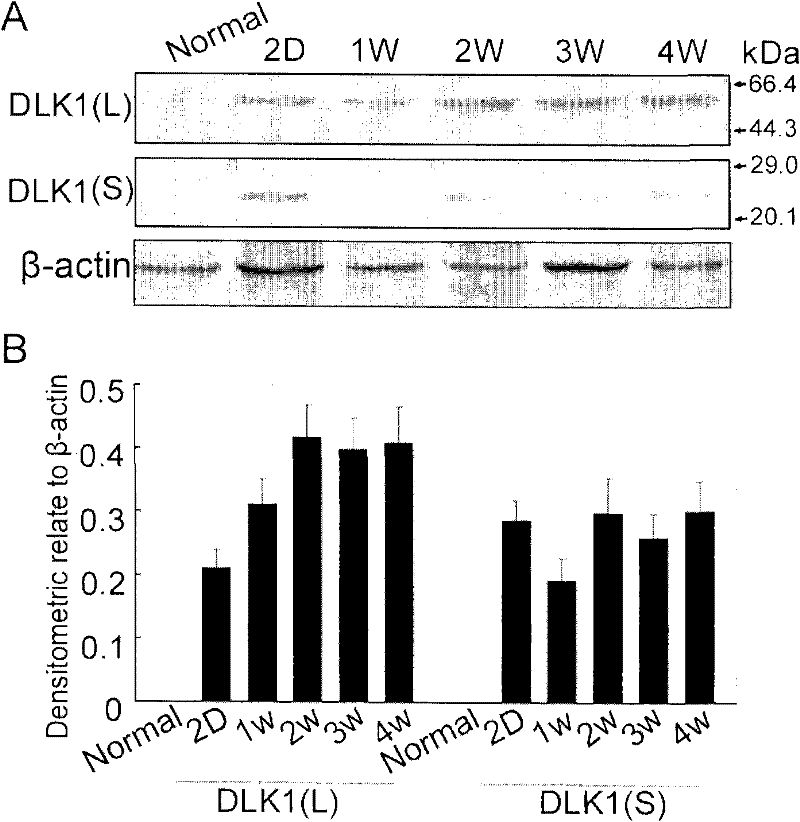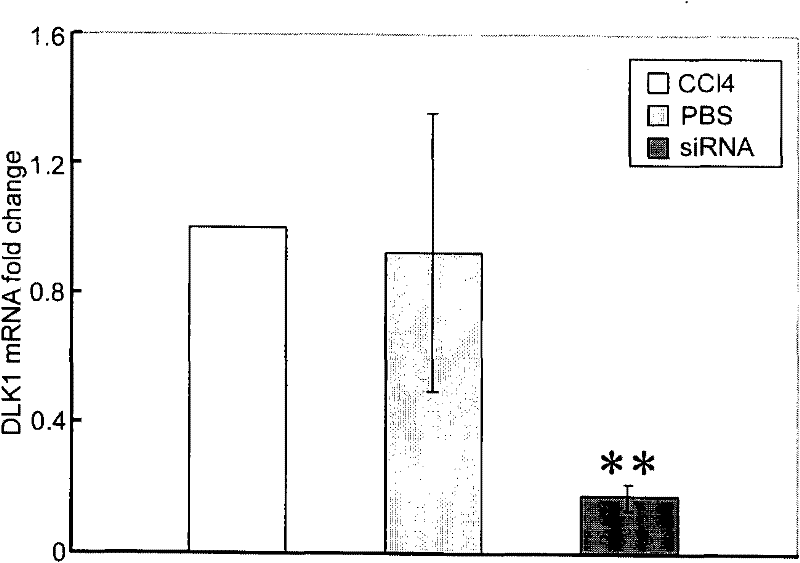Applications of DLK1 gene, siRNA (small interference Ribonucleic Acid), BM-MSCs (Bone Marrow Mesenchymal Stem Cells) and FGF2 (Fibroblast Growth Factor2)
A liver fibrosis and sequence technology, applied in DNA/RNA fragments, recombinant DNA technology, gene therapy, etc., can solve unclear problems and achieve the goal of reducing the degree of liver fibrosis, inhibiting HSC activation, and reducing the level of liver fibrosis Effect
- Summary
- Abstract
- Description
- Claims
- Application Information
AI Technical Summary
Problems solved by technology
Method used
Image
Examples
Embodiment 1
[0045] Example 1: Preparation of chronic liver injury mouse model and detection of DLK1 expression
[0046] Utilize 10% (volume concentration) carbon tetrachloride (solvent is olive oil) to induce chemical liver damage to the ICR mice (about 30 grams of body weight) of mouse age of eight weeks, each mouse is intraperitoneally injected 0.25ml 10% CCl 4 , 2 times a week, continuous injection for 4 weeks, to establish the liver fibrosis model, and the injected mice were fed normally in a sterile environment.
[0047] Extract the total protein from the liver of normal mice, 2 days after injury, 1, 2, 3 and 4 weeks, and detect the expression of DLK1 by Western blot: take 50 μg of protein as a sample, run SDS-PAGE electrophoresis; plain film) for 2 hours; according to 0.1ml / cm 2 Add blocking solution to the membrane area, that is, 2% BSA (2g BSA dissolved in 100ml PBST, wherein PBST is PBS plus 0.05% (volume ratio) TWEEN20), shake gently at room temperature for 2 hours; discard the...
Embodiment 2
[0049] Example 2: In vitro experiments prove that DLK1 promotes HSC activation
[0050] Separation and culture of HSC cells: Normal mouse liver, perfused with collagenase-pronase, collected individual dispersed hepatocytes, carefully added the cell suspension to 8.2% Nycodenz (Axis-shield), centrifuged at 800g for 25 minutes, and collected the middle layer of HSC cells , IMDM (supplemented with 10% FBS and 1% penicillin / streptomycin) 37°C, 5% CO 2 Conditioned cultivation.
[0051] DLK1 protein preparation: clone the extracellular region and signal peptide of DLK1 gene and adjacent 1-3 EGF-like structures; insert the cloned fragment into the vector pCDNA6; transfect HEK293 cells with liposome 2000; collect without serum after 72 hours of transfection The cell supernatant was centrifuged at 500g for 10min; the expressed protein was detected by western blot; the protein expressed in the extracellular region was DLK1 large fragment (DLK1-L) free protein, and the protein expressed...
Embodiment 3
[0058] Example 3: siRNA inhibits DLK1 expression, reduces HSC activation and liver fibrosis
[0059] The above-mentioned liver fibrosis model mice, CCl 4 In the second week of injection, siRNA against DLK1 was injected into the tail vein, and the sequence was:
[0060] 5'-P.CCCUAUUAAUGCAUGAUAAdTdT-3' (forward), SEQ ID NO: 1;
[0061] 5'-P.UUAUCAUGCAUUAAUAGGGAG-3' (reverse) SEQ ID NO:2.
[0062] Synthesized by Shanghai Gemma Pharmaceutical Technology Co., Ltd.
[0063] 50μg siRNA dissolved in 1ml PBS was quickly injected through the tail vein, and then each mouse was injected again 8 hours and 24 hours later (50μg siRNA); at the same time, other mice with the same injury were injected with 1ml PBS as a control. Afterwards, all mice were subjected to liver injury according to the above method for 2 weeks, and the liver tissue of the mice was taken, and a part of the total RNA was extracted with TRizol (Invetigen). The extraction method was carried out according to the instruc...
PUM
 Login to View More
Login to View More Abstract
Description
Claims
Application Information
 Login to View More
Login to View More - R&D
- Intellectual Property
- Life Sciences
- Materials
- Tech Scout
- Unparalleled Data Quality
- Higher Quality Content
- 60% Fewer Hallucinations
Browse by: Latest US Patents, China's latest patents, Technical Efficacy Thesaurus, Application Domain, Technology Topic, Popular Technical Reports.
© 2025 PatSnap. All rights reserved.Legal|Privacy policy|Modern Slavery Act Transparency Statement|Sitemap|About US| Contact US: help@patsnap.com



